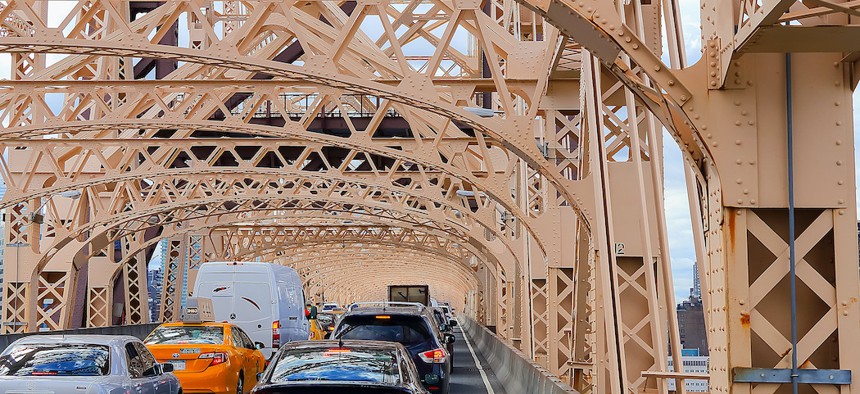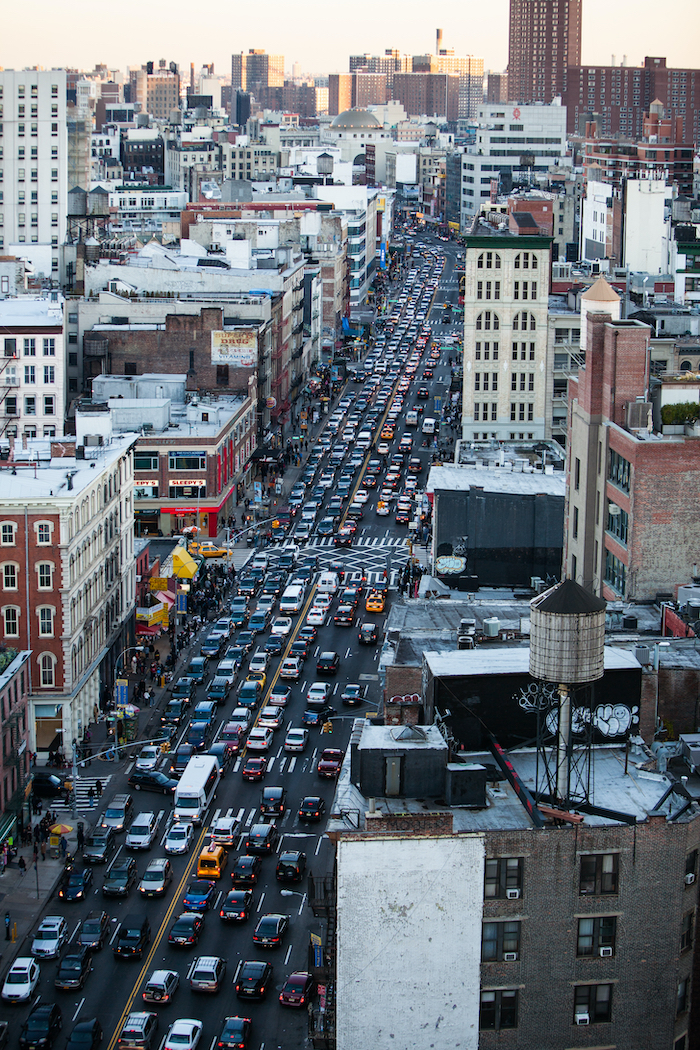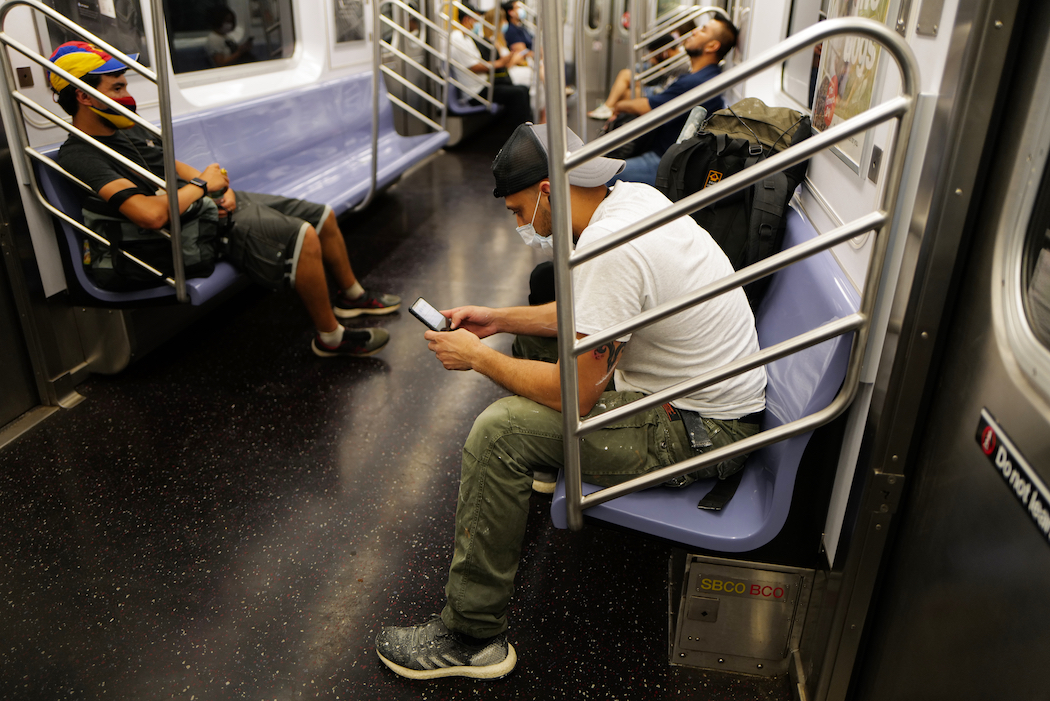New York City
Carmageddon is nigh
If commuters all take to their cars – or even just stay home – the MTA is doomed.

Traffic jam on the Queensboro Bridge. agsaz/Shutterstock

Even if some portion of workers don’t return to offices at all until there is a vaccine, experts say that just a modest change in the number of cars circulating around Manhattan makes a difference. “A small increase in the number of vehicles in a finite system can actually kind of crash the entire system,” said Tom Wright, president and CEO of the Regional Plan Association, a New York City metro area planning think tank. Wright used an increase of 10,000 vehicles as an example – an increase New York may not see this year or even early next year, but which could be a long-term change in the coming years. “In the entire quarter of a million people driving around New York to get to work on a daily basis, 10,000 more might not sound like a big deal. It’s not even a 10% increase,” Wright said. “It’s actually the difference between the system functioning and completely crashing.”
Of course, it’s worth questioning why people would go back to an office but not take public transit. Plenty of working-class New Yorkers – mostly people of color – who cannot work remotely, have been going to their jobs throughout the pandemic. Many of them ride the subways and buses because they have no other choice. For them, and New York as a whole, the mass transit system has to keep working, and a long-lasting loss of ridership could destroy it.
Before urban planners and transit experts can worry about straphangers turning into road warriors, they first have to ask whether workers will come back to the office at all. “This idea that, ‘Oh, Phase 4, everyone’s going to come back to their office after Labor Day’ – I think it’s kind of a fantasy,” said Nicole Gelinas, a senior fellow at the Manhattan Institute. Gelinas guessed it could be a year before we see even half of those currently working from home return to the office. “Realistically, we’re looking into next summer,” she said. “Then you start to think about the winter weather and everything else.”
If people aren’t eager to return to mass transit as long as COVID-19 is on the loose – and current data suggests they’re not – then the same fears that keep them away from subways and buses should logically apply to the office as well. That’s especially true in New York City, where office buildings are vertical, leading to crowded elevators and lobbies, and featuring windows that don’t open. “There is still no way to get these office workers (safely) back into these office buildings,” Gelinas said. “The elevator problems in themselves – that’s a congestion problem.”
In fact, the office is probably a more likely site of viral transmission than the subway – as car commuters in sprawling states with current coronavirus outbreaks, such as Texas and Florida, can attest. In New York City’s subways, filtered air circulating around a car is replaced with fresh air at least 18 times an hour, The New York Times reported. In an office, the recommended rate of replacement is only six to eight times an hour. Add to that the fact that we sit in an office for eight hours a day, and on the subway for maybe an hour. If the advantage of bringing people back to the office is so they can talk to one another – something most try to avoid on the subway – that raises the risk, since talking can generate the respiratory droplets that spread the coronavirus. Vigilant mask-wearing at the office all day might be less practicable, or anyway less widely practiced, than on the subway too. “I definitely think that there’s the chance that a significant fraction of the workforce will not return until we have a vaccine in place,” said Nick Sifuentes, executive director of the Tri-State Transportation Campaign. “And that makes sense to me. It is more risky to be in an elevator (than on the subway).”
“This idea that, ‘Oh, Phase 4, everyone’s going to come back to their office after Labor Day’ – I think it’s kind of a fantasy.” – Nicole Gelinas, senior fellow at the Manhattan Institute
Emerging reports suggest public transit does not actually pose a great risk of transmission. In Paris and Tokyo, for example, no COVID-19 clusters have been linked to public transit, studies show. “Even though the data indicates that it’s very safe to ride mass transit – that as long as people are wearing masks and practicing safe behavior and washing their hands and stuff – it’s understandable that people will say, ‘Well, as long as I’m in my car, I’m totally fine,’” Wright said. “So there’s a kind of emotional side of it, that’s understandable.”
Nonetheless, it’s probably safe to assume some portion of the workforce currently working from home will gradually start to return to the office. Already, some are throwing around ideas including staggered arrival times, a return to private offices and flexible schedules that could have employees coming in two or three days a week, for example. Even if people do return to the office via mass transit but do so three times a week, that would be a 40% drop in ridership. A survey conducted by the Partnership for New York City, a business alliance, found that about 10% of workers planned to return to Manhattan offices by the end of the summer and 40% by the end of the year.
The risk then becomes that those who do return to the office don’t take public transit but commute by car – even if they’re being irrational in doing so. That would stand in the way of the Metropolitan Transportation Authority recovering much-needed farebox revenue and pose the risk of carmageddon – and all of the gridlock, safety and environmental concerns that go along with it.
The other risk is that until a vaccine arrives, an insufficient number of workers will return to the office, dashing the MTA’s hopes of recuperating some of its daily ridership in a meaningful way. Ironically, Gelinas said that in some sense she would welcome the sign of gridlocked streets at rush hour. “I think the fact that we don’t see a real gridlock, carmageddon problem is the real problem,” she said. “Of course, the transit people would say, ‘No, of course, you don’t want traffic armageddon.’ And, of course, you don’t. But at least it would be a sign that the demand is there.” Then, Gelinas said, the question becomes how to manage the demand.
“About five weeks ago, traffic volumes on the bridges into Manhattan were back to 90% of pre-pandemic levels. We weren’t even at Phase 2.” – Nick Sifuentes, Tri-State Transportation Campaign executive director
Carmageddon could manifest in a few ways and on a few different timelines. But already, anecdotal reports have emerged of New Yorkers buying their first cars, or at least being tempted by private vehicles because they fear mass transit. “Globally, we’ve seen it in other cities that are ahead of us on the recovery – people return and they decide to jump in their cars first,” Wright said.
Harboring any hope that more people riding cars and creating more gridlock could be offset by some workers not returning to the office is futile, Sifuentes said. “About five weeks ago, (the New York City Department of Transportation) was already saying that traffic volumes on the bridges into Manhattan were back to 90% of pre-pandemic levels. We weren’t even at Phase 2 of reopening at that point,” he said. “If that says anything, it’s that traffic is absolutely going to be worse. And any mitigating effect from people not working is going to be minimal in the face of the number of people who aren’t going to be on transit.”
But that also doesn’t mean traffic will surge to unmanageable heights. A recent report by the Regional Plan Association considers two scenarios for the return to work in the first quarter of 2021 and the effects each would have on the city’s transportation system. The authors called the first one a “stalled recovery,” in which job losses offset any gains from people returning to work, and 75% of workers who are able to telecommute choose to continue working from home. The second is a “steady recovery,” in which half of the jobs deemed “temporary job losses” are restored, and 50% of workers who are able to telecommute choose to continue doing so. In both scenarios, commuting to jobs in Manhattan is less than pre-pandemic levels. Under the “stalled recovery,” about 50% of commuting activity returns and vehicle travel reaches almost pre-coronavirus levels; in a “steady recovery,” about two-thirds of commuting activity returns and vehicle travel slightly exceeds pre-coronavirus levels.
“All over the world, as cities and countries have begun to reopen following COVID-related restrictions, there has been a consistent pattern where motorized travel has rebounded faster than public transit,” a New York City Department of Transportation spokesperson wrote over email. “There may be a combination of factors, including which industries recover faster and other policy choices, but it is likely that people have concerns with the levels of crowding often experienced on public transit.”
Eric Goldwyn, a research scholar at the New York University Marron Institute, pushed back on the idea that people would tolerate congestion that is worse than it was before the pandemic. “I’m sure traffic could get worse than it was pre-corona. But I just think if we’re talking about cars going 3 to 4 miles per hour, I don’t buy that in the central business district,” Goldwyn said. “I think people will stay home or people will bike, opt for transit.” At a certain point, he said, once gridlock is so intense that vehicle speeds slow down to walking speeds, people start to make new choices about how to travel.

At a certain point, once gridlock is so intense that vehicle speeds slow down to walking speeds, people start to make new choices about how to travel, Goldwyn said.
One consequence that risks going ignored in discussions about what happens if riders don’t return to transit is the effect service cuts would have on those who are already back on the rails. Brian Taylor, a professor of urban planning and public policy at the University of California, Los Angeles who is studying the effects of the pandemic on transportation, said that while New York City stands apart from other U.S. cities in the fact that people of all income strata take transit in normal times, right now, the people already getting back on subways and buses are more likely to be lower-income, people of color and immigrants. “The evidence that we’re looking at suggests that the people who are kind of coming back to transit now are on average sort of lower-income and have less auto access than the average transit rider back in January, February,” he said. “They’re more likely essential workers, they’re more likely low-income. So you can think of it as that social service mission of public transit – providing mobility for those without – being the central role that the systems are playing right now.” Cuts to service would presumably end up hurting those riders most.
A spokesperson for the MTA did not elaborate on what those specific cuts to service might include. “We have made it very clear that we have already expended the $4 billion we received earlier this year from the CARES Act and that without another $12 billion in federal assistance to help us get through 2021, all options remain on the table,” Aaron Donovan, an MTA spokesperson, wrote over email.
Advocates say that without federal assistance, the cuts needed to balance the agency’s budget would make the transit system unrecognizable. Ben Fried, communications director at the pro-transit think tank TransitCenter, floated the possibility of whole subway lines going out of service but he didn’t know specifically what those measures would be. “We’re hurtling towards this cliff. We don’t know what it is. We don’t know how deep it is. We don’t know what’s on the other side,” Fried said. “We just know that we need a bridge, or else we’re in trouble.”
“We’re hurtling towards this cliff. We don’t know what it is. We don’t know how deep it is. We don’t know what’s on the other side. We just know that we need a bridge, or else we’re in trouble.” – Ben Fried, TransitCenter communications director
There’s an opportunity for the federal government to pull the emergency brake and keep the MTA from falling off that cliff, but Republicans in Washington appear to be asleep at the switch. (In fairness, the federal CARES Act passed in the spring did include almost $4 billion for the MTA, but that only makes a dent in what the agency says it needs and is much smaller than many of the corporate bailouts included in that package.)
One of the ways the federal government is currently failing New York’s transit system is by preventing the implementation of congestion pricing, which could bring in $1 billion in revenue for the MTA annually. The feds are refusing to provide guidance about the type of environmental review that needs to be conducted before the plan can go forward.
Of the options not being held up by the federal government, there are smaller actions on the table, such as offsetting the traffic safety risk of increased driving by increasing traffic law enforcement. “What the state can do is a more aggressive network of speed and red light cameras that would both save lives and bring in some revenue they could dedicate to the MTA,” Gelinas said. Wright and the Regional Plan Association recommended instituting high-occupancy vehicle policies that restrict lanes of traffic to carpool or shared rides, although the organization acknowledged that HOV policies would be easier to implement after a vaccine, unless rides were shared by people who were already quarantining together.
And then there’s the suite of streetscape reforms that alternative transportation advocates have been backing for years. Though the “complete streets” movement has made strides in recent years – including a City Council package passed in 2019 that requires at least 150 miles of protected bus lanes and 250 miles of protected bike lanes over the next five years – they say more can be done. Citi Bike’s long-awaited expansion to the Bronx and Upper Manhattan also began this spring.
In June, New York City Mayor Bill de Blasio announced a plan to create 20 miles of new busways and dedicated bus lanes, and said that Manhattan’s 14th Street Busway – a pilot project completed last year – would be made permanent. In addition, bus lanes on 149th Street in the Bronx and on Malcolm X Boulevard in Brooklyn have been recently completed, a city Department of Transportation spokesperson said.
Since the pandemic began, the city has also pledged to temporarily create 100 miles of car-free space for pedestrians, cyclists and outdoor dining, but critics have called it a patchwork approach and are calling for more comprehensive changes. A proposal from the Regional Plan Association, for example, would create a 425-mile continuous network of protected bike lanes across the five boroughs.
New York’s appetite for biking has grown over the past few months, with many opting for bicycles, scooters and other similar transportation options. (One of these options, the moped rental company Revel, shut down its service this summer following the deaths of two of its riders.)
Sometimes, however, discussions about biking and other mobility options leave out those who live too far from the office to commute by bicycle. “Each mode of transportation is better served for certain conditions and certain distances,” Wright said. “I don’t expect people to start biking 10 miles each direction to their job or something.”
But Wright also raised the possibility that the city continues to move beyond the Manhattan core as the city’s only hub of commerce. “Brooklyn and Queens are the fastest growing – pre-COVID at least – the fastest-growing employment centers in the city. The Bronx has seen robust growth. So it’s not just all about trying to get people from outlying boroughs to Manhattan, but also improving mobility within them,” Wright said. “We know that the bike lanes and the bike network and bike-share systems are a really important, and frankly, cost-effective way of doing it.”
Already, some are looking toward the city’s 2021 elections for a massive change in how New York City designs its streets and how commuters navigate them. “If there’s a chance for a mayor – a new mayor or even a current mayor – to really make a mark and have a legacy, it is in reimagining what the streetscape looks like,” Sifuentes said. “If there’s anything COVID has shown us, it is that there’s a better way for our streets to look and to function and to feel. It’s like the one thing that people have enjoyed.”
Corrections: This article originally misstated the location of the bus lane on Malcolm X Boulevard. This article also originally gave the wrong timeframe for the RPA study.

NEXT STORY: Will Trump let congestion pricing happen?